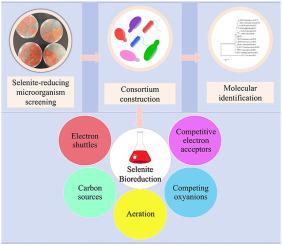Environmental Pollution ( IF 8.9 ) Pub Date : 2023-06-01 , DOI: 10.1016/j.envpol.2023.121948 Elham Lashani 1 , Hamid Moghimi 2 , Raymond J Turner 3 , Mohammad Ali Amoozegar 1

|
Selenium oxyanions are released into environments by natural and anthropogenic activities and are present in agricultural and glass manufacturing wastewater in several locations worldwide. Excessive amounts of this metalloid have adverse effects on the health of living organisms. Halophilic and halotolerant microorganisms were selected for selenium oxyanions remediation due to presence of significant amount of salt in selenium-containing wastewater. Effects of aeration, carbon sources, competitive electron acceptors, and reductase inhibitors were investigated on SeO32− bio-removal. Additionally, NO3−-containing wastewater were exploited to investigate SeO32− remediation in synthetic agricultural effluents. The results showed that the SeO32− removal extent is maximum in aerobic conditions with succinate as a carbon source. SO42− and PO43− do not significantly interfere with SeO32− reduction, while WO42− and TeO32− decrease the SeO32− removal percentage (up to 35 and 37%, respectively). Furthermore, NO3− had an adverse effect on SeO32− biotransformation by our consortia. All consortia reduced SeO32− in synthetic agricultural wastewaters with a 45–53% removal within 120 h. This study suggests that consortia of halophilic/halotolerant bacteria and yeasts could be applied to treat SeO32--contaminated drainage water. In addition, sulphates, and phosphates do not interfere with selenite bioreduction by these consortia, which makes them suitable candidates for the bioremediation of selenium-containing wastewater.
中文翻译:

嗜盐/耐盐细菌和/或酵母在盐水介质中的联合体对亚硒酸盐的生物还原
硒氧阴离子通过自然和人为活动释放到环境中,并且存在于全球多个地方的农业和玻璃制造废水中。过量的这种准金属会对生物体的健康产生不利影响。由于含硒废水中存在大量盐,因此选择嗜盐和耐盐微生物进行硒氧阴离子修复。研究了通气、碳源、竞争性电子受体和还原酶抑制剂对 SeO 3 2−生物去除的影响。此外,还利用含有NO 3 −的废水来研究 SeO 3 2−合成农业废水的修复。结果表明,在以琥珀酸盐为碳源的有氧条件下,SeO 3 2−去除率最大。SO 4 2−和 PO 4 3−不会显着干扰 SeO 3 2−的还原,而 WO 4 2−和 TeO 3 2−会降低 SeO 3 2−的去除百分比(分别高达 35 和 37%)。此外,NO 3 -对我们联合体的SeO 3 2-生物转化有不利影响。所有聚生体都减少了 SeO 3 2−在合成农业废水中,120 小时内可去除 45-53%。该研究表明,嗜盐/耐盐细菌和酵母菌的联合体可用于处理受 SeO 3 2--污染的废水。此外,硫酸盐和磷酸盐不会干扰这些聚生体对亚硒酸盐的生物还原,这使它们成为含硒废水生物修复的合适候选物。



























 京公网安备 11010802027423号
京公网安备 11010802027423号